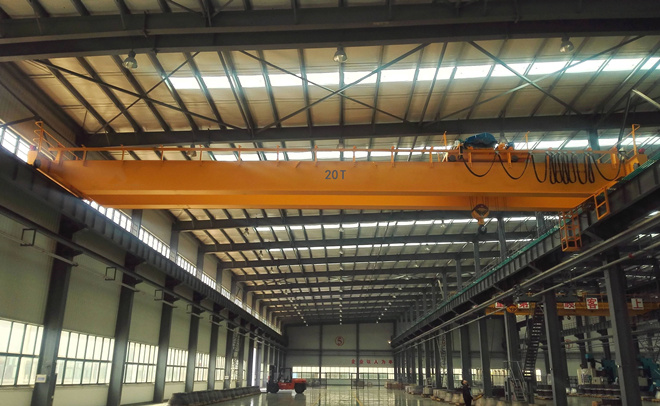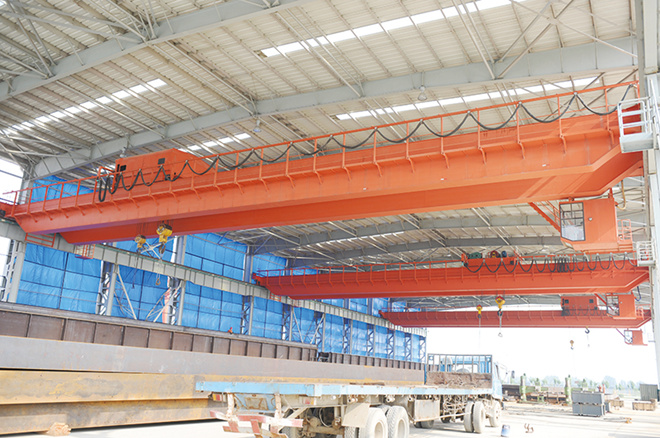Double girder bridge cranes are crucial in various industrial settings, offering robust and reliable lifting solutions for heavy and large loads. Designing a custom double girder bridge crane involves several critical considerations to ensure it meets specific operational needs while maintaining safety, efficiency, and durability. Here, we explore the essential design considerations for custom double girder bridge cranes.
Load Capacity and Weight Distribution
The primary factor in designing a custom double girder bridge crane is determining the load capacity. This involves:
- Assessing maximum load requirements: Identify the heaviest load the crane will need to lift, including any potential future increases in load requirements.
- Calculating weight distribution: Ensure the crane can evenly distribute the load across both girders to prevent structural stress and potential failures.
- Including safety margins: Incorporate safety margins in the design to account for dynamic loads and unforeseen stresses.

Span and Dimensions
The span of the crane, which is the distance between the runways, is a critical design element:
- Measure the operational area: Accurately measure the width and height of the area where the crane will operate to determine the appropriate span and dimensions.
- Consider the building structure: Ensure the design accommodates existing building structures, such as columns and beams, to avoid interference.
- Allow for future expansion: Design the crane with potential future expansions in mind, ensuring it can be adapted or extended if necessary.
Material Selection
Selecting the right materials for the crane’s construction impacts its strength, durability, and cost:
- High-strength steel: Use high-strength steel for the girders and other structural components to ensure maximum load-bearing capacity and longevity.
- Corrosion resistance: Consider materials with corrosion-resistant properties, especially if the top running crane will operate in harsh environments or outdoors.
- Lightweight materials: Where possible, incorporate lightweight yet strong materials to reduce the overall weight and ease installation.
Hoisting Mechanism
The hoisting mechanism is the core component of the crane, responsible for lifting and lowering loads:
- Choose the right type of hoist: Options include wire rope hoists and chain hoists, each with its advantages. Wire rope hoists are typically used for higher load capacities and longer lifts, while chain hoists are suitable for lighter loads and shorter lifts.
- Motor power and speed: Select a motor with sufficient power to handle the maximum load, and consider the required lifting speed for your operations.
- Safety features: Ensure the hoist includes essential safety features such as overload protection, emergency stop mechanisms, and fail-safe brakes.
Control System
The control system is vital for the safe and efficient operation of the crane:
- Manual vs. automated controls: Decide between manual controls, automated systems, or a combination of both. Automated systems can enhance precision and efficiency but may require more complex integration.
- Remote operation: Consider incorporating remote control capabilities to allow operators to control the crane from a safe distance, enhancing safety and flexibility.
- Integration with existing systems: Ensure the control system can be integrated with existing facility management and safety systems for seamless operation.

Safety Features
Safety is paramount in crane design to protect both personnel and equipment:
- Limit switches: Install limit switches to prevent the crane from traveling beyond its designated range, reducing the risk of collisions and accidents.
- Load sensors: Integrate load sensors to monitor the weight being lifted and prevent overloading.
- Emergency stop systems: Ensure the crane has easily accessible emergency stop systems that can quickly halt operations in case of an emergency.
- Fall protection: Implement fall protection measures for maintenance personnel working at heights, such as guardrails and harness attachment points.
Environmental Considerations
The operating environment significantly influences the crane’s design:
- Indoor vs. outdoor use: Design the crane to withstand environmental conditions, whether it will be used indoors or outdoors. Compared to indoor overhead cranes, outdoor cranes may require additional weatherproofing and corrosion protection.
- Temperature variations: Consider the range of temperatures the crane will be exposed to and select materials and components that can perform reliably under those conditions.
- Dust and contaminants: In environments with high levels of dust or contaminants, design the crane with sealed components and easy-to-clean surfaces to maintain performance and longevity.
Maintenance and Accessibility
Design the crane for ease of maintenance to ensure long-term reliability:
- Accessible components: Ensure that all critical components, such as the hoist, motor, and control systems, are easily accessible for inspection, maintenance, and repair.
- Modular design: Consider a modular design that allows for easy replacement of parts without requiring extensive disassembly.
- Maintenance platforms: Include maintenance platforms or walkways for safe access to high and hard-to-reach areas.
Regulatory Compliance
Adhering to relevant regulations and standards is crucial for safety and legal compliance:
- Industry standards: Design the crane to meet industry standards such as those set by the Occupational Safety and Health Administration (OSHA) and the American National Standards Institute (ANSI).
- Local regulations: Ensure compliance with any local regulations and building codes that may apply to crane machine installations.
Cost Considerations
While cost is always a factor, it should not compromise safety or performance:
- Budget planning: Establish a clear budget that includes not only the initial design and installation costs but also long-term maintenance and operational expenses.
- Cost-benefit analysis: Perform a cost-benefit analysis to balance the initial investment with the crane’s expected performance, durability, and maintenance requirements.
By carefully considering these design factors, you can create a custom double girder bridge crane that meets your specific needs, operates safely and efficiently, and provides long-term reliability. Whether for manufacturing, construction, or other industrial applications, a well-designed crane is an invaluable asset.